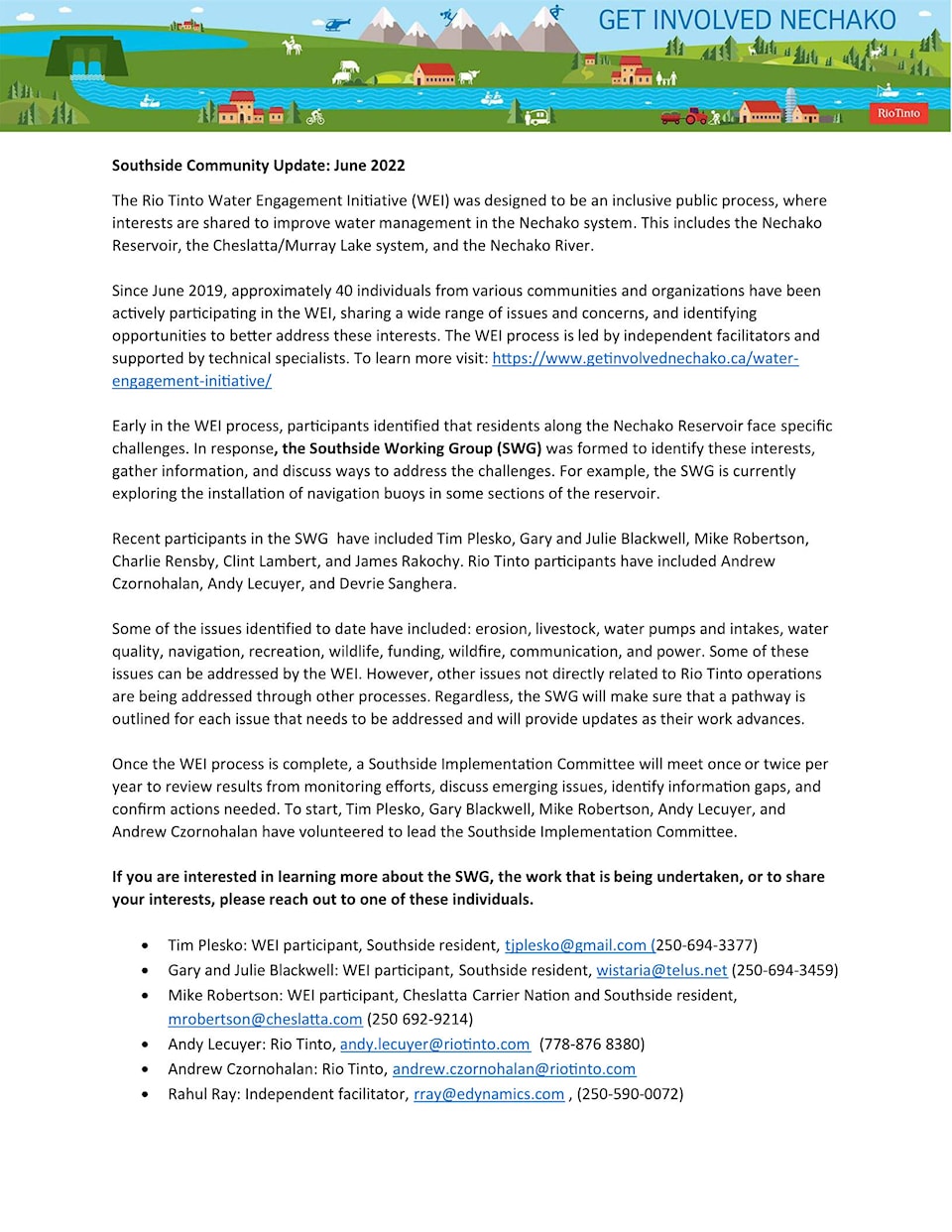The Southside Working Group, formed as a part of Rio Tinto’s Water Engagement Initiative (WEI), is working to outline issues and will be forming a committee to oversee implementation and redressal of issues raised by the residents.
According to resident and part of the working group, Tim Plesko, currently work is being done to facilitate the installation of navigational aids to mark safe passageways leading to the portage.
“This is from Ootsa Lake to Big Eusik lake. There will be a series of navigational buoys installed to mark hazards and safer deep channels for travellers by boat to the portage. These will be installed and removed each spring and fall due to the ice movement on the reservoir during spring breakup,” he said.
The Water Engagement Initiative, which began its work in June 2019, saw participation from roughly 40 community members, sharing a wide range of issues and concerns, and identifying opportunities to better address these interests. Once it was identified that residents on the Southside faced unique challenges with respect to the Nechako Reservoir, the Southside Working Group was formed.
Some of the issues identified to date have included: erosion, livestock, water pumps and intakes, water quality, navigation, recreation, wildlife, fish, funding, wildfire, communication, and power.
“As a permanent resident that lives on the reservoir, I see how the weather can change very quickly. This makes traveling on the reservoir extremely dangerous. The WEI process has been a great tool to allow community input, sharing the realities of living and working on the reservoir, it allows concerns to be voiced,” said Plseko.
For the group, safety on the water and accessible use of the reservoir are at the top of the list, when it comes to concerns around the reservoir. Fish and wildlife habitat also rank high on the list, along with erosion and driftwood debris which restrict the access to shoreline on the reservoir.
“This summer we are seeing the first changes of identified concerns to be implemented. These changes for the better should help anyone using this part of the reservoir. This will be great for all the community and visitors,” noted Plesko. “These markers will help save lives and equipment, by helping keep boaters out of the submerged trees and off near surface shallow shoals.”
The group is also looking into some possible dock locations, and the design and logistics of how these docks will be used and maintained.
Currently, several community members along with Plesko, such as Gary and Julie Blackwell, Mike Robertson, Charlie Rensby, Clint Lambert, and James Rakochy, have participated in the Southside Working Group. And the WEI process has proven to be very helpful to the residents.
“The WEI process has allowed me to voice my concerns. Previously, it has been very difficult to communicate and discuss ongoing identified issues with the water licensed operator of the reservoir, Rio Tinto,” said Plesko, adding, “We will have an ongoing long term locally recognized group, and contact persons, that will be able to have access more directly with Rio Tinto.”
Once the WEI process is complete, a Southside Implementation Committee will meet once or twice per year to review results from monitoring efforts, discuss emerging issues, identify information gaps, and confirm actions as needed.
Tim Plesko, Gary Blackwell and Mike Robertson, from the Southside Working Group, and Andy Lecuyer, and Andrew Czornohalan from Rio Tinto, have volunteered to lead the Southside Implementation Committee.
“There has been a change in how Rio Tinto has viewed and is doing business in our communities. They seem to be more receptive and respectful to the population that their operation is affecting,” remarked Plesko.
The ongoing long term working group of local residents is now encouraging any resident of the reservoir to bring their observations and concerns to the group, Plesko added.
“The concerns or observations can then be passed on to the Rio Tinto representative on the committee. This person is responsible to respond in a timely manner to the query. This is a great change from past operational days,” he concluded.
